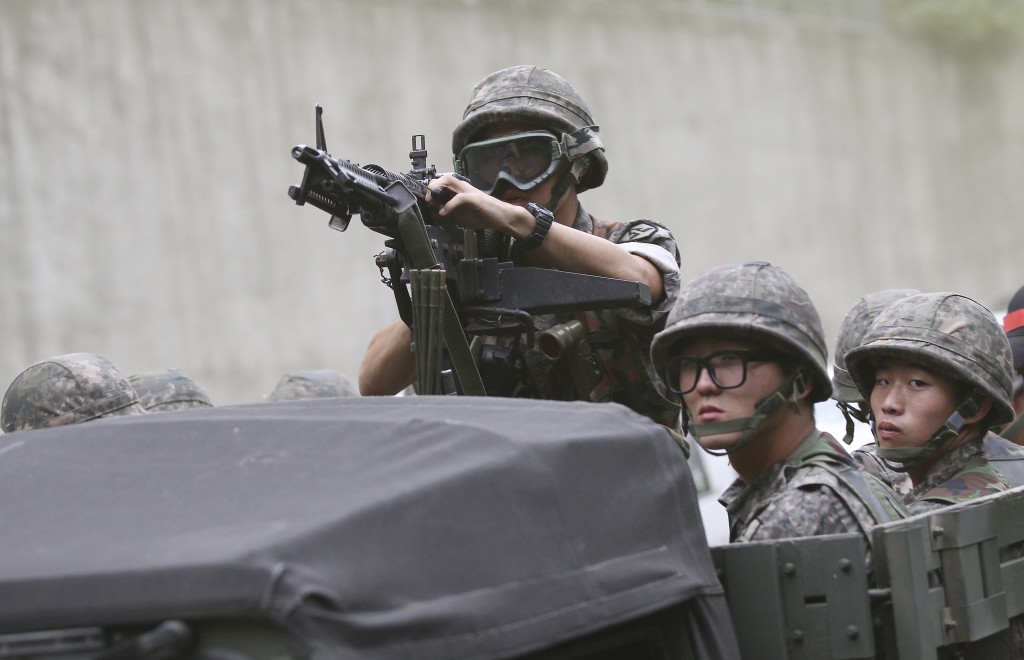- California Assembly OKs highest minimum wage in nation
- S. Korea unveils first graphic cigarette warnings
- US joins with South Korea, Japan in bid to deter North Korea
- LPGA golfer Chun In-gee finally back in action
- S. Korea won’t be top seed in final World Cup qualification round
- US men’s soccer misses 2nd straight Olympics
- US back on track in qualifying with 4-0 win over Guatemala
- High-intensity workout injuries spawn cottage industry
- CDC expands range of Zika mosquitoes into parts of Northeast
- Who knew? ‘The Walking Dead’ is helping families connect
Pope leaves, and Joint military drill starts; NK repeats threats

A South Korean aims his machine gun during an anti-terror exercise as part of Ulchi
Freedom Guardian in Seoul, South Korea, Monday, Aug. 18, 2014. The U.S.-South Korean military exercises start Monday and involving tens of thousands of troops are described by the allies as routine and defensive, but Pyongyang sees them as invasion preparation. (AP Photo/Ahn Young-joon)
By Jun Ji-hye
South Korea and the United States began Ulchi Freedom Guardian (UFG), Monday, an annual joint combat readiness exercise that will run through Aug. 29.
North Korea responded with repeated threats to attack the U.S. mainland and Seoul.
The UFG exercise comprises a set of defensive drills designed to maintain the combined defense posture on the Korean Peninsula.
“Fifty thousand Korean and 30,000 American troops are participating in the exercise,” said an official from the Ministry of National Defense.
The Swiss and Swedish delegations of the Neutral Nations Supervisory Commission are observing, he added.
It is notable that South Korea and the U.S. have applied for the first time a “tailored” strategy aimed at deterring North Korea’s possible use of nuclear weapons or weapons of mass destructions during this year’s exercise.
Tailored deterrence is a comprehensive approach that covers how to respond to different levels of military threats posed by the North in peacetime and wartime.
The strategy was drawn up during the two countries’ 45th Security Consultative Meeting in Seoul last October. The then-Defense Minister Kim Kwan-jin and his Washington counterpart Chuck Hagel endorsed the plan.
“The exercise is an unacceptable provocative behavior that infringes upon the peace structure of the peninsula and damages inter-Korean relations,” the North’s state newspaper, the Rodong Sinmun, said.
With regard to the two countries’ first application of the new strategy, the newspaper continued, “That amounts to a declaration of nuclear war… If any unforeseeable situations occur on the peninsula due to the UFG drills, all responsibility will fall on the U.S. and South Korea.”
The military said it is running the exercise on full alert, given that the level of Pyongyang’s rhetoric is deemed more intense than in previous years.
“The military will reinforce manpower for surveillance missions during the drill period,” said a military official.
The government is also paying keen attention to whether the North accepts Seoul’s earlier offer for high-level talks to be held at the truce village of Panmunjeom.
Seoul had offered to hold the talks on Tuesday, but Pyongyang has not responded.
While the Stalinist state is fiercely opposing the military exercise, it has not shown hostility toward the talks.
When Kim Yang-gon, director of the North Korean United Front Department, met Rep. Park Jie-won of the New Politics Alliance for Democracy to deliver a wreath, presented by North Korean leader Kim Jong-un to mark the fifth anniversary of the death of former President Kim Dae-jung, he asked: “Why are the drills conducted now when the South proposed holding the talks?”
But Kim did not make hostile remarks about the offer, indicating that the North could again resort to its well-known tactic in which it shows off its military capabilities while at the same time expressing its eagerness to prove it is seeking peace on the Korean Peninsula.












![일본 사도광산 [서경덕 교수 제공. 재판매 및 DB 금지]](http://www.koreatimesus.com/wp-content/uploads/2024/07/PYH2024072610800050400_P4-copy-120x134.jpg)


